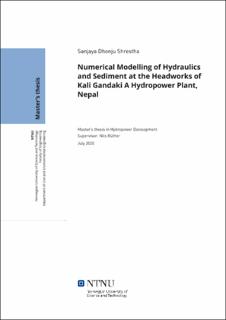| dc.description.abstract | The Kali Gandaki A Hydropower Plant (KGA) has been facing issues related to unfavourable flow conditions at intake and settling basins, thereby hindering the efficient settling of the sediments, as realized from the excessive sediment-induced turbine erosion. With an intention to counteract these issues, investigations were conducted in a physical hydraulic model that recommended design modifications to the existing headworks arrangements based on improved hydraulic performance and qualitative evaluation of flushing efficiency. However, the performance of the settling basins with the modified geometry in relation to suspended sediments is still unresolved. Hence, the present study aims to assess the same, by utilizing the numerical model in SSIIM 1, including sediment concentration distribution and bed deposition pattern.
A 3D numerical model with structured and non-orthogonal grid was used for the simulation. The numerical model (scale of 1:40; as adopted for physical hydraulic model) was first calibrated against the measured velocities at intake and settling basins in the physical hydraulic model. The porosity approach was used to represent the effect of the wire mesh used in physical hydraulic model (representing trash rack in the prototype). The simulations were also tested for two grid resolutions (coarse and fine) and two discretization schemes (Power-Law (POW) scheme and Second Order Upwind (SOU) scheme). The fine grid resolution with porosity of 0.55 and POW scheme produced the best conformity (among the trials made) with the measurements, and hence was opted for the sediment simulation in prototype scale (1:1), obtained by scaling up the geometry of the calibrated numerical model.
Sediment simulation involved four size fractions and was carried out for two different scenarios: without and with bed changes. The former utilized the results from the hydraulic simulation while the latter used the flow field recomputed after the update of the bed. Sensitivity analysis was also considered for different fall velocities corresponding to two different water temperatures (20 °C and 10 °C). The trap efficiencies estimated from the simulations were also compared with those estimated from the analytical methods.
The sensitivity test showed that the reduction in fall velocities (water temperature at 10 °C) mainly influence the trap efficiency for the finer size fractions. Besides, the rate of decrease in sediment concentration and magnitude of the deposits are also reduced. Nevertheless, the trend of reduction in sediment concentration and bed deposition pattern appears similar to the observations made with higher fall velocities (water temperature at 20 °C).
Significant improvement in the trap efficiency of the settling basins is observed with the recommended modifications in comparison to the trap efficiency of the existing structure measured in recent years. The smallest value for overall trap efficiency observed among all the simulations is 60%, which is 19% higher compared to that measured in 2018. However, the simulation time was limited to a single day, and hence the value is expected to decrease with an extended simulation time. Similarly, the simplifications adopted in the geometry, errors due to numerical approximations, possible bugs, inaccuracy of empirical formula for sediment concentration, errors due to not complete convergence in time-dependent computation, etc. further add uncertainties to the results. | |
